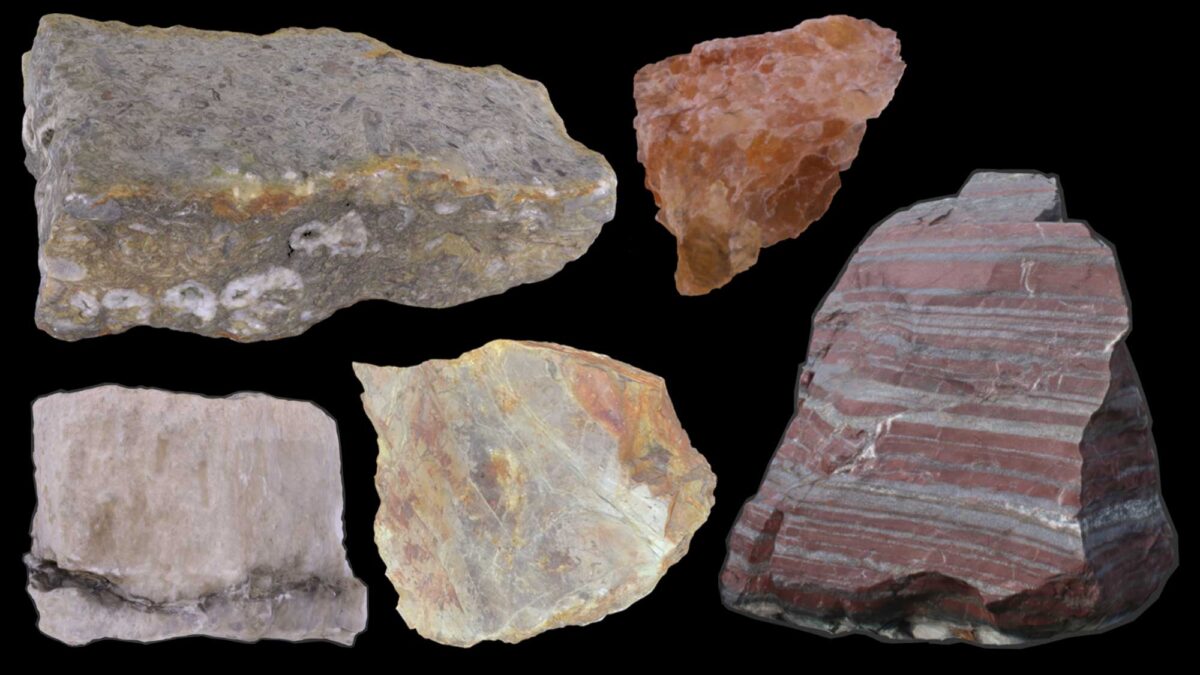Virtual Rock Collection
Igneous Rocks
Sedimentary Rocks
Metamorphic Rocks
Image above: Examples of different types of chemical and organic sedimentary rocks. Sources of individual rock images are derived from 3D models on Sketchfab with Creative Commons licensing; see same models below for creator credits and licensing details.
Overview
Chemical and organic sedimentary rocks are those that are precipitated from chemicals that are dissolved in water or are produced by the activities of organisms, or the accumulation of their remains. In contrast to siliciclastic sedimentary rocks that are composed of sediment grains that may have traveled great distances prior to being deposited, chemical and organic sedimentary rocks more-or-less formed where you find them. There are five major groups: carbonates, evaporites, chert, banded iron, and coal.
Carbonates
There are two major kinds of carbonate rocks, both of which are composed of minerals with a (CA₃)⁻² anion: limestones and dolostones.
Limestone
Limestones are composed of calcium carbonate (CaCO₃) and are often produced by organisms, including algae, microscopic organisms called foraminifera, and animals such as corals, snails, and clams. Note that some of these organisms produce skeletons composed of the mineral calcite, while others use aragonite; both minerals have the formula CaCO₃. If a weak acid is applied to limestone, it will fizz, a property that is very useful for identifying this type of rock. Several different types of limestone are presented below.
Large limestone block on exhibit outside the Museum of the Earth, Ithaca, NY. The dark-colored layer in the middle of the block is chert (see below) (Sketchfab; Creative Commons Attribution-ShareAlike 4.0 International license).
Fossiliferous Limestone
As implied by its name, fossiliferous limestones contain abundant remains of ancient organisms.
Fossiliferous limestone from the Ordovician Kope Formation of Kentucky. Specimen is from the teaching collections of the Paleontological Research Institution, Ithaca, NY. Longest dimension of specimen is approximately 14 cm (Sketchfab; Creative Commons Attribution-ShareAlike 4.0 International license).
Coquina
Coquina is a form of limestone that is composed almost entirely of the broken fragments of the calcium carbonate skeletons of invertebrate animals (commonly the shells of mollusks).
Limestone coquina of broken mollusk shells. Specimen is from the teaching collection at the Paleontological Research Institution, Ithaca, New York. Length is approximately 10 cm (Sketchfab; Creative Commons 0 public domain license).
Chalk
Chalk is a form of limestone composed of the calcitic skeletons of microscopic algae called coccolithophores. It is a very soft type of rock, making it useful for writing on chalk boards. It is often white or tan in color.
Oolitic Limestone
Oolitic limestone is composed of tiny sphere-shaped grains of calcium carbonate called ooids.
Travertine
Travertine is a form of limestone that often precipitates from groundwater in caves or in association with hotsprings. It often has a fibrous texture and/or shows concentric layering. Travertine is commonly used as a building material or in sculptural artwork.
Dolostone
Dolostone is composed of the mineral dolomite [CaMg(CO₃)₂)]. Instead of being precipitated directly by organisms, dolostone is usually formed by alteration of limestone when some of the calcium is replaced by magnesium. Dolostone also fizzes when it comes into contact with acid, but the degree of fizzing is not as vigorous.
Original caption: "This nondescript rock is a sample of the Lockport Dolomite from near Rochester, New York. It is almost entirely made of dolomite. It is 9 cm wide." Model by "rocksandminerals" (Sketchfab; Creative Commons Attribution 4.0 International license).
Evaporites
Evaporites are rocks composed of minerals that remain after seawater evaporates from an area. They are less common than many other types of sedimentary rocks, though may be locally abundant. Examples include rock salt and rock gypsum.
Rock Salt (Halite)
Rock salt is composed of the mineral halite (NaCl).
Original caption: "Drill core of halite (rock salt). Gorleben, Lower Saxony, Germany." Model by Sara Carena (Sketchfab; Creative Commons Attribution-NonCommerical 4.0 International license).
Specimen of rock salt comprised of the mineral halite. Note that rock salt can be many different colors and is often gray or colorless. Longest dimension of specimen is 9 cm (Sketchfab; Creative Commons Attribution-NonCommercial 4.0 International license).
Rock Gypsum
Rock gypsum is composed of the mineral gypsum (CaSO₄.2H₂O).
Sample of the sulfate mineral gypsum from the teaching collections of the Paleontological Research Institution. Longest dimension of specimen is 8 cm (Sketchfab; Creative Commons Attribution-ShareAlike 4.0 International license).
Original caption: "This rock is made just about entirely of gypsum. It comes from Fremont County, Colorado. The specimen is 9 cm in longest dimension." Model by "rocksandminerals" (Sketchfab; Creative Commons Attribution 4.0 International license).
Diatomite
Diatomite is a type of organic sedimentary rock that is composed almost entirely of the microscopic skeletons of algae called diatoms. These tiny skeletons are composed of silica.
Chert
Chert (also known as flint) is a rock that is often formed from the skeletons of microorganisms and sponges that make their skeletons out of SiO₂. Because it is hard and may be modified to produce sharp cutting edges, it was once widely used to produce projectile points (e.g., arrowheads) and other cutting and scraping tools.
Franciscan chert from the Marin Headlands Terrane, near San Francisco, California. Model by Ron Schott (Sketchfab; Creative Commons Attribution-NonCommercial 4.0 International license).
Specimen of chert from Dover, England. Specimen is "7.5 cm across." Model by "rocksandminerals" (Sketchfab; Creative Commons Attribution 4.0 International license).
Original caption: "Discovered in Watauga County, NC in 1994 by Margot Birckhead. Pleistocene-aged Clovis point made of black Chert from the Knox formation. Weight: 5.1g Length: 41.36mm Width: 19.81mm Thickness: 5.13mm The point was presented for custody to the Eastern Band of Cherokee Indians in 2016." (Sketchfab; Creative Commons Attribution 4.0 International license).
Banded Iron
Banded iron is an extinct type of chemical sedimentary rock that only formed during the Precambrian when oxygen levels were much lower than they are today. The rock is often easily identified by its alternating layers of red and gray. Banded iron formations provide much of the world's supply of iron ore, which is critical for the production of steel.
Coal
Coal is a fossil fuel derived from the remains of ancient plants that accumulated in low oxygen environments (e.g., swamps) and were then subjected to burial and heating. This type of rock is almost always brown or black in color and consists mostly of carbon. As metamorphism transforms coal from lignite to bituminous coal to anthracite, it becomes darker in color and richer in carbon; the rock itself also becomes harder. Because anthracite coal has the highest carbon content, it is also the most valuable type of coal.
Lignite Coal
Specimen of lignite coal. Model by "tfrank2" (Sketchfab; Creative Commons Attribution-NoDerivatives 4.0 International license).
Bituminous Coal
Specimen of bituminous coal. Model by "Edurock" (Sketchfab; Creative Commons Attribution 4.0 International license).
Anthracite Coal
Specimen of anthracite coal. Model by "Edurock" (Sketchfab; Creative Commons Attribution 4.0 International license).



